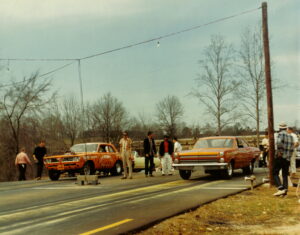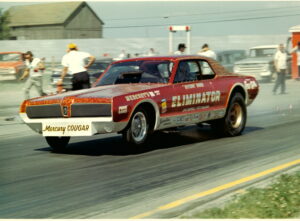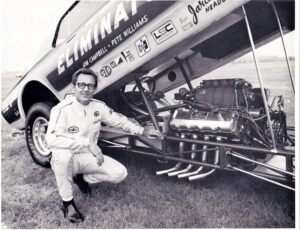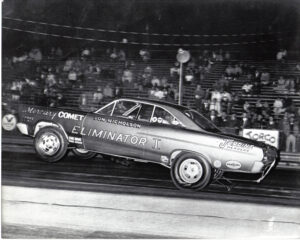It Runs in the Family…
Don Nicholson, founder of ELEVATE, grew up around the fury of the most powerful machines in motorsports—drag racing cars.Modern Top Fuel Funny Cars generate over 10,000 horsepower and accelerate to over 330mph (530kph) in less than five seconds. The most distinctive attribute to a Funny Car (other than the powerful engine), is the unique “flip top” characteristic of the entire car body. Who developed, tuned, and raced the first “flip top” Funny Car? “Dyno Don” Nicholson, the Great-Uncle of ELEVATE’s Don Nicholson.
Dyno Don Nicholson passed away at the age of 78 in early 2006.
Learn more about Dyno and see a full timeline of all his race cars at: www.dynodon.com
Below is a great history of Dyno Don Nicholson and his career from the NHRA website (http://www.nhra.net/50th/top50/D_Nicholson18.html)
There have been few drag racers equipped with more versatile skills as a driver and engine builder/tuner than “Dyno Don” Nicholson.
Originally a circle-track roadster campaigner in the late 1940s and then a participant in dry-lakes racing in El Mirage, Calif., and Bonneville, Utah, Nicholson went on to become a pioneer in Stock, Factory Experimental, Funny Car, and Pro Stock competition.
Because his career spanned the 1960s and 1970s when there were relatively few NHRA national events on the calendar, the bulk of his wins came in match race competitions, where he usually won more than 90 percent of his races.
Many drag racing historians agree that if Nicholson had been able to race in the 1980s and 1990s, he would have compiled an NHRA record similar to that of Funny Car racer John Force (97 career wins) and Pro Stock racers Warren Johnson (86) and Bob Glidden (85).
Still, Nicholson holds the record for final-round appearances in the most NHRA eliminator categories, scoring either wins or runner-up efforts in Funny Car, Pro Stock, Super, Comp, Stock, and Street.
He was the first Ford campaigner to win a national event in Pro Stock, at the 1971 Summernationals, and he earned the NHRA Winston Pro Stock championship title in 1977 at the age of 50.
During the era of manually shifted four-speed transmissions, Nicholson had no equal because in addition to driving, he also turned his own wrenches. Ronnie Sox might have been his equal with the four-speed, but Sox never worked on his cars. Bill Jenkins was a more innovative engine builder, but he preferred to let other individuals such as Dave Strickler and Larry Lombardo do the driving whenever possible.
One of Nicholson’s advantages was that he already had raced for many years in other forms of motorsports by the time that sanctioned dragstrips began to open up at various locations throughout Southern California.
He earned his “Dyno” nickname as one of the first to utilize the benefits of a chassis dyno, which he operated at a Chevrolet dealership in Pasadena, Calif., in the late 1950s. By the time that NHRA announced to hold its first Winternationals at Pomona Raceway in 1961, he was ready to put his well-honed skills to use.
Nicholson not only won the Stock title at the ’61 Winternationals, but he also successfully defended his title in 1962 to become a household name in drag racing circles throughout the country.
Match race promoters in the Southeast offered him so many lucrative bookings that he soon relocated to Atlanta to compete against the likes of Strickler, Sox & Martin, the Ramchargers, Dick Landy, Arnie Beswick, Dick Brannan, Phil Bonner, and Gas Ronda. During the mid-1960s, these rising stars popularized the pre-race rosin burnout rituals, and their contingent of fans grew from hundreds to thousands.
When Chevrolet dropped their factory backing in 1963, Nicholson jumped to an A/Factory Experimental Mercury Comet in 1964 and enjoyed a match race winning percentage in excess of 90 percent that year.
Jim Thornton, driver of the feared Ramchargers Dodge team, said, “When we raced Nicholson, we knew we had to be ready. He and his mechanic, Earl Wade, were very tough.”
Buddy Martin, who along with Sox also ran a Comet A/FX car in 1964, said, “The thing about Nicholson was that he was always looking for an edge. He never showed up just hoping that he could win. He did everything he could to come up with any kind of performance advantage he could get.”
Sox added, “The thing I remember most about Nicholson is that sometimes he’d show up at the track at the last minute, and sometimes he didn’t look very organized. He’d be working on the car right up to the first run, then he’d go out and make the quickest run of the day. He was amazing.”
There was a method to Nicholson’s unorthodox approaches. Though he had a few weeks to prepare his 409-engine prior to the ’61 Winternationals, he did not take delivery of his Chevy Bel Air until the day before the race.
Fearing that the new suspension would be too stiff to provide proper weight transfer to the rear tires, he had one of his crew members drive the car roughly 500 miles that night to loosen up the front shocks and coil springs.
Nicholson was also among the first racers to use narrow rims to accentuate the wrinkled-sidewall effect on the tires in the mid-1960s. He accordingly recorded the first 10-second runs for a doorslammer with his ’64 A/FX Comet and was also the first to begin lifting the front wheels of the ground on gear changes.
The rivalry between the Dodge-Plymouth teams and the Ford-Mercury camp was extremely intense in the mid-1960s, and Chrysler made major moves for 1965 by luring Sox & Martin from Mercury to Plymouth and gained a significant performance advantage by moving the front and rear wheels forward for superior traction.
The cars were declared illegal for NHRA competition, but their nine-second performances easily outclassed the 10-second potential of the NHRA-legal Ford and Mercury entries. When Ford subsequently disallowed their cars from competing against the new Mopar “Funny Cars,” Nicholson faced a serious loss in match race income.
By August, Nicholson was forced to take matters into his own hands, and he converted his A/FX Comet into a Funny Car by altering the wheelbase and adding fuel injection and nitromethane fuel. Weeks later, he defeated the swiftest Mopar entry, the Ramchargers Dodge, in a pivotal match race with 9.30, 150-mph clockings.
Mercury’s racing manager, Al Turner, had the foresight to envision where the whole Funny Car phenomenon was headed, and he accordingly commissioned the Logghe Bros., of Detroit, to build tube-chassis Comets with one-piece flip-top bodies for the 1966 season.
This gave Nicholson such a performance advantage that the only driver who had the potential to defeat him was his protégé and Comet teammate, Eddie Schartman. Today’s Funny Cars still use the same flip-top format that was established by Nicholson’s Eliminator I Comet.
Nicholson was virtually undefeated in 1966 and recorded the first Funny Car seven-second clocking at Martin, Mich., late that summer.
He enjoyed another banner season in 1967 with his Eliminator II, but when Funny Cars switched to supercharged engines late that year, Nicholson became concerned with the danger of blower explosions and engine fires. After completing the 1968 season with his 7.3-second Eliminator Cougar, Nicholson teamed with Sox & Martin, Bill Jenkins, and Dick Landy to form a match race circuit with carbureted, four-speed-equipped heads-up Super Stock cars, a throwback to the original A/FX vehicles of the mid-1960s.
“The Funny Cars had just gotten too out of hand,” said Nicholson. “They no longer resembled what Detroit was trying to sell. Chrysler already had backed out of Funny Car racing in 1967 when they had Sox & Martin and Landy start their Super Stock clinics. We just wanted to get our original fans back.”
Nicholson converted Jerry Harvey’s 1966 A/FX Mustang into a heads-up Super Stocker and drove it to a victory in Street at the 1969 Springnationals while campaigning the car in A/MP. The popularity of the heads-up nine-second entries on the match race circuit prompted NHRA to create the Pro Stock category in 1970.
Competing with a hastily prepared Ford Maverick that was built in just seven days, Nicholson qualified for the Winternationals but fell to the overwhelming number of Dodge and Plymouth entries. He became dominant on the match race circuit, however, and during one August stretch ran up a streak of 45 consecutive round-wins. Working with assistants Earl Wade and Dave McGrane, he perfected the SOHC 427 Hemi combination and became Ford’s first Pro Stock winner with his victory at the 1971 Summernationals.
Nicholson switched to a 351-Cleveland small-block-powered Ford Pinto in 1972, and the move eventually rewarded him with three consecutive wins at the AHRA Winternationals and NHRA Winternationals and Gatornationals to open up the 1973 season.
He was runner-up at the 1974 U.S. Nationals and 1976 Summernationals as a warm-up to his championship campaign of 1977. He won the Gatornationals, Springnationals, and U.S. Nationals in five final-round appearances in 1977 to claim the Winston title.
But a deciding factor in his championship season was a race that he did not win. Nicholson’s chief rival at the time was defending 1976 champion Larry Lombardo, who drove Bill Jenkins’ Monza.
Championship points at that time were earned at both national and divisional races, and though Nicholson had run his quota of divisional races, he attended an event that Lombardo needed to win and ran as a blocker.
“We qualified low on purpose so that we could race Larry early in eliminations,” said Nicholson. “I beat him in the first round and kept him from earning a lot of points he otherwise would have earned.”
Lombardo eventually slipped to third in the points standings, and Nicholson beat out second-place Bob Glidden by more than 1,400 points to earn the national title.
Nicholson continued to campaign with his Ford entries through the 1980 season. He made a comeback effort in 1984 with an Oldsmobile before retiring from Pro Stock at age 57.
In 1988, however, he returned to drag racing with a nostalgia version of his 7.5-second, 152-mph Chevy Bel Air, and he made a brief attempt in Pro Stock Truck competition in 1998 and 1999.
Nicholson earned the Car Craft All-star Drag Racing Team Ollie Award in 1977 and was Funny Car Driver of the Year in 1967.
He has been inducted into the International Drag Racing Hall of Fame in Ocala, Fla., and the Motorsports Hall of Fame in Novi, Mich. Nicholson was most recently honored as the grand marshal of the California Hot Rod Reunion in 1997, and he is spending this season running his exhibition car in the Super Chevy racing series.

Group of Men Gathered and Talking

Black and White Drag Race Cars Next to Each Other

Don Smiling Next to Red Car

Black and White Dyno Don Mustang II Pro Stocker

Red Comet Cyclone Drag Race Vehicle

Yellow Drag Race Car Racing on Track

Don Watching Drag Race

Black and White Don Working on Car Engine

Black and White Drag Race Vehicle

Dyno Don Eliminator at Residents Gold Cup Drag Races

Two Drag Racing Cars Next to Each Other

Yellow Dyno Don Vehicle Racing with Large Crowd

Dyno Don Red Eliminator Vehicle Parked

Eliminator Drag Racing

Two cars drag racing

Eliminator II Drag Racing with Large Crowd on the Side

Black and White Racing Image with Eliminator II

Black and White Eliminator II Vehicle Displaying Engine

Black and White Eliminator I Drag Racing

Eliminator I Drag Race Car with Three Men Sitting Near The Vehicle

Black and White Eliminator II Racing

Yellow Drag Racing Vehicle

Black and White Dyon Don Racing in Car

Dyno Don yellow racing car

Black and White Dyno Don holding baby next to car

Black and White Dyno Don Vehicle With Group of Men Around

Black and White Dyno Don Man Getting Into Car

Black and White Dyno Don Man Raising Frame of Car

Black and White Dyno Don Driving Image

Black and White Dyno Don Vehicle Racing

Black and White Comet Car Driving

Black and White Man by Car Engine and Raised Car Frame

Mercury Comet Eliminator Car on Back of Truck

Black and White Don Nicholson car driving

Black and White Don Nicholson car

Don Nicholson car and driver

Don Nicholson Eliminator I

Black and White Dyno Don with White Car Nalley and Nicholson Driving

Black and White Dyno Don with White Car Nalley and Nicholson

Red Mercury Cougar Car

Black and White Dyno Don by a Raised Car Frame and Engine

Dyno Don Mr Gasket Co Car
